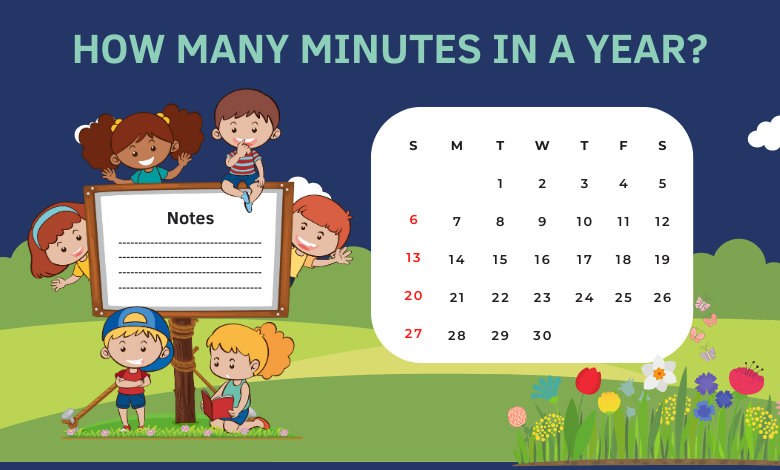How Many Minutes in a Year?
How Many Minutes are in a Year? (Use Our Online Converter for Quick Results)

There are 525,600 minutes in a year.
Ever caught yourself wondering, “How many minutes in a year?” You’re definitely not alone! It’s one of those quirky questions that sneaks up when you’re planning a big project, tracking time for fun, or just daydreaming about how fast life moves. Lucky for us, the answer’s pretty straightforward—and even better, tools like our online converter make it a total breeze. Let’s dig into the details: how many minutes are in a year, how to figure it out yourself, and why leap years throw an extra twist into the mix.
How Many Minutes Are in a Year?
So, how many minutes are in a year, really? For a regular year—no leap nonsense involved—it’s 365 days. The math’s simple enough:
365 days × 24 hours/day × 60 minutes/hour = 525,600 minutes.
That’s right—a cool 525,600 minutes in a standard year! It’s wild to think about how much happens in that time, from morning coffees to late-night Netflix binges. This number assumes a typical 365-day year, which covers most of the calendar. But leap years? They shake things up a bit, and we’ll unpack that in a sec.
How Do You Calculate Minutes in a Year?
Want to know how many minutes in a year without a fancy tool? It’s all about basic multiplication—and honestly, it’s kind of satisfying to do it yourself. Start with the days: 365 for a regular year (or 366 for a leap year). Then:
- Multiply by 24 (hours in a day).
- Multiply that by 60 (minutes in an hour).
For a standard year, it looks like this:
365 days × 24 hours = 8,760 hours
8,760 hours × 60 minutes = 525,600 minutes.
If it’s a leap year, just bump that first number to 366, and you’re golden. It’s a fun little exercise—and a great party trick if you’re ever stuck for small talk!
Use Our Online Converter for a Quick Results
Manually calculating minutes in a year is straightforward but can be time-consuming, especially if you’re working with multiple years or leap years. Our free online converter simplifies the process. Just input the number of years, specify if it’s a leap year, and get instant results in minutes.
Time Unit Converter
How to Use the Converter
- Enter the number of years (e.g., 1, 5, or 10).
- Click “Convert” to see the total minutes.
The tool also allows you to calculate minutes for fractions of a year or multiple years, making it versatile for various needs.
Converting Minutes to Other Time Units
Once you know how many minutes are in a year, you can convert those minutes into other time units for different perspectives. Here’s how:
- Seconds in a year: 525,600 minutes × 60 seconds/minute = 31,536,000 seconds
- Hours in a year: 525,600 minutes ÷ 60 minutes/hour = 8,760 hours
- Weeks in a year: 525,600 minutes ÷ (60 minutes/hour × 24 hours/day × 7 days/week) = approximately 52.14 weeks
These conversions can be handy for specific calculations, such as determining how many seconds you’ve been alive or how many hours a project will take over a year.
How to Convert Minutes to Years
Sometimes the question flips—say you’ve got a giant stack of minutes and want to know how many years that covers. No problem! Since a regular year has 525,600 minutes, just divide your total by that:
Total Minutes ÷ 525,600 = Number of Years.
For instance, if you’re staring at 1,051,200 minutes:
1,051,200 ÷ 525,600 = 2 years.
It’s a handy trick for turning a random minute count—like how long you’ve been alive—into something that makes sense. Try it out with your age in minutes for a fun twist!
What’s a Leap Year All About?
Okay, let’s talk leap years—those sneaky calendar quirks. A leap year adds an extra day to keep our schedules synced with Earth’s orbit around the Sun. Normally, we get 365 days, but every four years, February stretches to 29 days instead of 28. Why? Because a year’s actually 365.2425 days long—not a neat little 365. That extra day keeps holidays and seasons from drifting out of whack.
Here’s the catch:
- It’s a leap year every four years…
- Unless the year’s divisible by 100 but not 400—then it skips the leap.
(Think 2000: leap year. 1900: nope.)
It’s a clever system, and it’s why figuring out how many minutes in a year isn’t always the same answer.
How Many Minutes in a Leap Year?
So, how many minutes are in a year when it’s a leap year? With 366 days, the total jumps a bit higher. Here’s the breakdown:
366 days × 24 hours/day × 60 minutes/hour = 527,040 minutes.
That’s an extra 1,440 minutes—or one full day—compared to a regular year’s 525,600. It’s amazing how much difference a single day makes when you zoom in like that!
Calculating Minutes in a Leap Year
Curious how to calculate how many minutes in a year that’s a leap year? It’s the same deal as before, just with 366 days:
- Start with 366.
- Multiply by 24 hours.
- Multiply by 60 minutes.
Here’s the step-by-step:
366 days × 24 hours = 8,784 hours
8,784 hours × 60 minutes = 527,040 minutes.
It’s a small tweak, but it’s neat to see how that extra day adds up. You could watch a lot of movies in those bonus minutes!
Minutes in a Decade? Here’s the Scoop
What if you’re thinking bigger—like a whole decade? Since a 10-year stretch mixes regular and leap years, the total varies. Most decades have 2 leap years and 8 regular ones:
2 × 527,040 (leap) + 8 × 525,600 (regular) = 5,256,000 minutes.
But some decades, like 2020–2029, sneak in 3 leap years:
3 × 527,040 + 7 × 525,600 = 5,283,840 minutes.
Imagine all the things you could do with over 5 million minutes—it’s mind-blowing to think about!
Why Our Converter’s a Total Win
Our online tool isn’t just quick—it’s a game-changer. No more stressing over miscalculations or digging out a calculator. Whether you’re sorting time for work, school, or just because you’re curious about how many minutes in a year, it’s built to be easy and accurate. Bonus: it works for months, weeks, or days too—perfect for anyone who loves playing with time!
Frequently Asked Questions (FAQs)
1. How Many Minutes in a Month?
Depends on the month:
- 31 days (Jan, Mar, etc.): 31 × 24 × 60 = 44,640 minutes.
- 30 days (Apr, Jun, etc.): 30 × 24 × 60 = 43,200 minutes.
- February (regular): 28 × 24 × 60 = 40,320 minutes.
- February (leap): 29 × 24 × 60 = 41,760 minutes.
2. How Many Minutes in a Day?
24 hours × 60 minutes = 1,440 minutes.
3. How Many Minutes in a Week?
7 days × 1,440 minutes = 10,080 minutes.
4. How Many Minutes in an Hour?
Straight-up 60 minutes.
5. How Many Minutes Until 3 PM Today?
Check the clock—say it’s 12:30 PM on March 21, 2025: 2.5 hours = 150 minutes.
6. How Many Minutes Is 900 Seconds?
900 ÷ 60 = 15 minutes.
7. Quick Hacks for Any Time Period?
- Hours to minutes: × 60.
- Days to minutes: × 1,440.
- Weeks to minutes: × 10,080.
- Months: Days × 1,440.
8. How Many Minutes in a Century?
Roughly 75 regular years, 25 leaps:
(75 × 525,600) + (25 × 527,040) = 52,596,000 minutes.
9. Smaller Units?
- 1 minute = 60 seconds.
- 1 second = 1,000 milliseconds.
10. Why More Minutes in Leap Years?
Earth’s orbit is 365.2425 days, not 365. Every four years, we add a day to match up, giving leap years those extra 1,440 minutes.
Conclusion
In conclusion, there are 525,600 minutes in a standard year and 527,040 minutes in a leap year. While the calculation is simple, it can be tedious to do manually, especially when dealing with multiple years or determining if a year is a leap year. Our online converter simplifies this process, providing quick and accurate results for any year you input.
Understanding how many minutes are in a year can be more than just a mathematical exercise; it can help you manage your time better, set achievable goals, and appreciate the value of each minute. So, the next time you’re planning your year or pondering the passage of time, remember that every year is made up of hundreds of thousands of minutes—each one an opportunity to make the most of your time.




